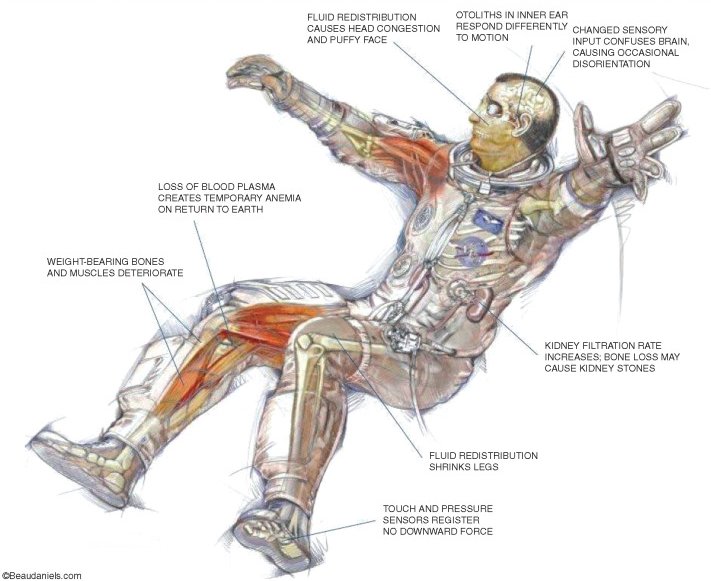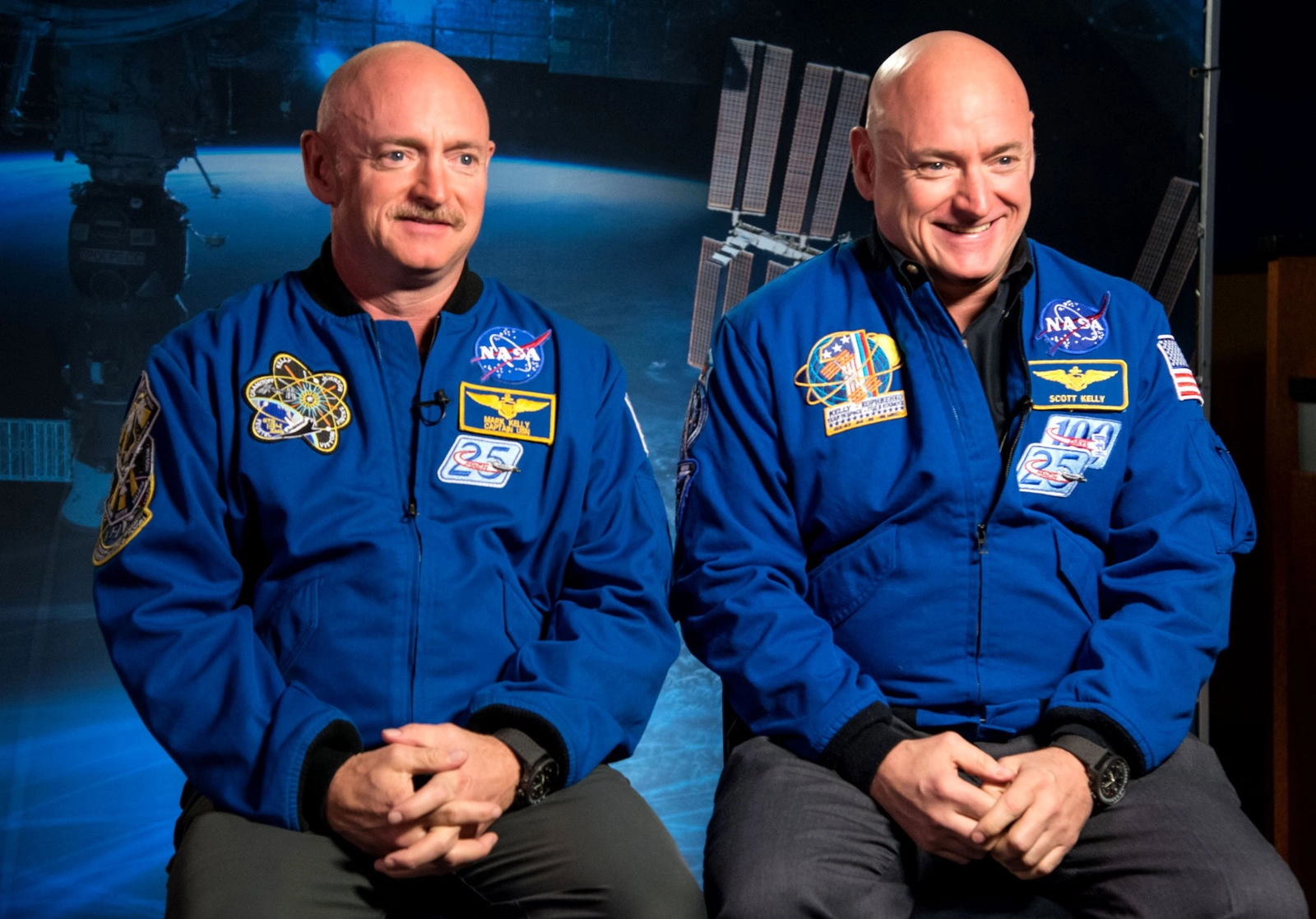- British Journal of Anaesthesia – An overview of space medicine
- NASA – Bioastronautics Roadmap. A Risk Reduction strategy for Human Space Exploration
- Science – The NASA Twins Study: A multidimensional analysis of a year-long human spaceflight
- frontiers – Growing Tissues in Space
The human body in outer space
If NASA is to send people to Mars, it needs to know the effects of a space flight on the human body. The perfect solution: comparing an astronaut in space with his twin brother on Earth.
Adaptation to space: a crucial research field
Translated from the original French version
Having orbited the Earth for almost 25 years, the International Space Station is a gigantic research laboratory. Many scientific experiments are carried out there in a wide variety of fields such as astrophysics, materials physics, fluid mechanics and plant and animal biology. One of the most important areas of research is the study of how the human body adapts to the conditions in space.

Some of the physical effects of a prolonged stay in space. (Copyright: Hodkinson et al. – An Overview of Space Medicine1)
Astronauts are their very own guinea pigs
The changes that the space environment causes to the human body have been studied and documented for decades.2 The most well-known are decalcification and weakening of bones, loss of muscle tone, reduced (temporary or long-term) sensory and motor skills, cardiovascular disorders and eye conditions (see Medical Science to Conquer Mars). In the vast majority of cases, these disorders can be alleviated by appropriate physical exercise during the stay in space, and they gradually disappear once the astronaut returns to Earth.
That said, studying individuals selected to go into space is not an easy task. Indeed, in the absence of a control person, it is sometimes difficult to attribute certain physiological changes to space conditions and not, for example, to the natural variability of the human body under stress.
Also, studies on astronauts often collect data on a single biological factor, disregarding the concurrent effects on multiple variables. These studies have often been restricted to missions of less than six months. The following experiment was therefore designed to obtain a real overview of all the changes that an astronaut's body undergoes in space.
The chosen American astronaut was Scott Kelly. The main consideration was that he has a twin brother, Mark Kelly, who is a former astronaut and former pilot of the US Space Shuttle. Since both share the same genetic make-up, studies on twins allow us to analyse how human health is affected by the environment, irrespective of physical changes linked to any genetic predisposition.

Mark Kelly (left) and Scott Kelly (right) (Copyright: NASA)
So, for this experiment, Scott travelled to the International Space Station in March 2015 and spent some 340 days on board. Meanwhile, his brother Mark underwent the same series of tests on Earth. Over a period of 25 months (before, during and after Scott Kelly's stay on the ISS), physiological, telomeric, transcriptomic, epigenetic, proteomic, metabolic, immunological, microbiomic, cardiovascular, ocular and cognitive data were gathered.
The follow-up report was published3 in April 2019. According to Susan Bailey, co-author of the paper, this was "the most comprehensive assessment we have ever had of the human body's response to spaceflight".
Changes to the DNA
Certain physiological functions were similar in both brothers and remained unaffected by the flight into space. For example, the immune response to the first vaccine test in space was satisfactory – in this case against influenza. Based on this finding, vaccinations can now be considered for long-term missions.
Other characteristics varied significantly, but returned to the same levels after the flight. To the scientists' surprise, Scott Kelly's telomere length increased substantially during his stay, only to return to “normal” length a few days after his return to Earth.
Telomeres are the non-coding ends of each DNA strand and possess specific characteristics to protect the chromosomes. They tend to shorten with age. However, lifestyle and environmental factors can influence the pace of this shortening.
Samples taken before, during and after Scott's mission in space revealed that some changes in gene expression had occurred. Mark also experienced changes in gene expression on Earth, but of a different nature.

The study carried out on the twin astronauts Scott & Mark Kelly over a period of 25 months, 12 of which were spent in orbit around the Earth by Scott. (Copyright: Garrett-Bakleman et al.)
Temporary effects
Some of the physical changes in Scott might be related to his long stay in space. However, most of these changes disappeared again six months after his return to Earth. The scientists assume that some of the damage to the DNA observed can be traced back to the body's exposure to radiation. Scott Kelly's gut microbiome also changed significantly during his flight, but then returned to normal at the end of the experiment.
As far as cognitive abilities are concerned, they remained largely unchanged during Scott's stay in space (mental alertness, spatial orientation, etc.). This means that astronauts can maintain a high level of cognitive performance during long missions. The decrease in mental speed and accuracy observed after landing and which persisted for six months, might simply be a result of readjustment to Earth's gravity and Scott's busy days after his mission.
Staying in an environment as alien as space significantly alters the functions of the human body, from organs to DNA. And although these changes almost all disappear upon return to Earth, their study remains essential to prepare for future long-duration space stays. In the near future, this will be on the Moon, and in the more distant future, on other planets in the Solar System.
"We cannot send humans to Mars without knowing how spaceflight affects the body, including the microbes travelling with humans to Mars," said the author of the microbiome study, Fred W. Turek, about Scott's mission. With NASA's goal of sending people to Mars in 2035, time is running out.
Research in space with potential applications on Earth
Certain medical studies cannot be carried out on the actual astronauts. One example of this are cell cultures. Under the influence of Earth's gravity, these kinds of experiments sometimes provide a distorted representation of cell behaviour in a living organism. The reason for this is that the cells reside in a completely different environment than the human body when they are at the bottom of a Petri dish, for example.
In microgravity on the ISS, cells form complex 3D structures that more closely resemble real tissue. This provides a much better model for studying their behaviour and evolution, for example to advance regenerative medicine or to test the effects of new pharmaceuticals.
It has been shown4 that human thyroid cancer cells or endothelial cells form some type of 3D spheroid aggregates after being exposed to microgravity for 14 days. During the formation of these aggregates, it was possible to investigate the factors involved in angiogenesis, cell proliferation and adhesion, migration or extracellular matrix signalling. The research results have very practical implications: They could help in the development of human tissue, which could then be used in transplantations or for the development of drug tests.
Also by Pierre Henriquet: